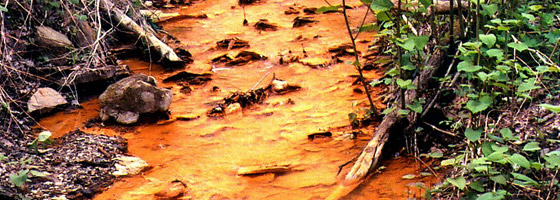Acid Mine Drainage

Acid mine drainage, commonly referred to as AMD, is a pervasive problem in many areas of the world. In fact, it is considered one of the main pollutants of surface water in the eastern United States. Characterized by high levels of acid, sulfate, and metals, AMD exerts both lethal and sub-lethal effects on aquatic life, pollutes drinking water, and corrodes manmade structures, including barges, bridges, culverts, and pipelines (Earle and Callaghan, 1998).
Acid mine drainage is formed when certain sulfide-containing minerals are exposed to oxygen and water. Pyrite, or iron disulfide, is one of the most common sulfide-containing minerals that cause AMD. Because pyrite is commonly associated with bituminous coal seams, AMD often occurs with coal mining.
Four reactions are commonly recognized to describe the process of acid mine drainage generation (Stumm and Morgan, 1970). The first reaction, the oxidation of pyrite by oxygen in the presence of water, results in the release of ferrous iron, sulfate, and hydrogen ions (Figure 1). Subsequently, in the presence of oxygen, ferrous iron will be oxidized to ferric iron (Figure 2). Ferric iron precipitates under oxygenated conditions above a pH of approximately 3.5, which releases more hydrogen ions, hence producing more acidity (Figure 3). Additionally, ferric iron that does not precipitate may oxidize pyrite, generating ferrous iron, sulfate, and hydrogen ions (Figure 4). These 4 equations can be combined into the following general equation (Figure 5).
The detrimental effects of this process on aquatic environments are numerous. The iron precipitate created in equation (3) causes sedimentation problems, smothers aquatic life, and degrades aquatic habitat. This precipitate, commonly called yellowboy, occurs in varying shades of yellow, red, and orange. It is the most obvious indicator of AMD.
The lowered pH, besides causing direct stress to aquatic plants and animals, promotes the dissolution of other metals in the surrounding rocks. Depending on the geochemistry of the area, this may lead to high concentrations of toxic metals in the water and sediments. Many of these metals also form precipitates that coat stream bottoms and manmade structures.
Both the formation and treatment of AMD is site-specific and depends on the hydrology, chemistry, microbiology, and geology of the area. Numerous methods for treatment exist, and they fall into two general categories: active and passive. All methods target raising the alkalinity of water, neutralizing the acidity, and precipitating metals in a confined area.
Active treatment involves the frequent addition of alkaline chemicals, such as hydrated lime, ammonia, and soda ash, in order to neutralize acidity and precipitate metals. Such treatment requires constant attention and maintenance, generally making them cost-prohibitive.
Passive systems are generally preferred due to a lower operational cost. These involve the construction of environments that clean contaminants through natural processes with little maintenance. Examples include the construction of ponds, wetlands, and buried neutralizing channels using materials such as cattails, compost, and limestone.
References:
- Earle, J. and Callaghan, T. 1998. Impacts of mine drainage on aquatic life, water uses, and man-made structures. Chapter 4 in Coal Mine Drainage Prediction and Pollution Prevention in Pennsylvania. Edited by: K.B.C. Brady, M.W. Smith and J. Schueck, Department of Environmental Protection, Harrisburg, PA.
- Stumm, W., and Morgan, J.J. 1970. Aquatic Chemistry: an Introduction Emphasizing Chemical Equilibria in Natural Waters. Wiley Interscience, New York. 583 pp
Image Credit: www.peakwater.org





0 comments